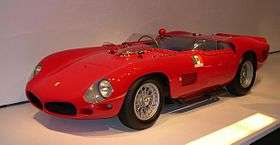Ferrari TR
| Ferrari Testa Rossa | |
|---|---|
| Overview | |
| Manufacturer | Ferrari[1] |
| Production | 1957-1958[1] |
| Assembly | Maranello [1] |
| Designer | Scaglietti[1] |
| Body and chassis | |
| Body style | spyder |
| Layout | FMR[1] |
| Powertrain | |
| Engine | 2953.21 cc [2] V12[1] |
| Transmission | 4 speed manual transmission + reverse [1] |
| Dimensions | |
| Wheelbase | 2,350 mm (92.5 in)[1] |
| Length | 3,959 mm (155.9 in) [1] |
| Width | 1,523 mm (60.0 in) [1] |
| Curb weight | 800 kg (dry) [2] |
The Ferrari TR, or 250 Testa Rossa, is a race car model built by Ferrari in the 1950s and 1960s. They were introduced at the end of the 1957 season in preparation for the regulations restricting sports cars to 3 litres for Le Mans and World Sports Car Championship races from 1958. These cars dominated their competitors, with variations winning 10 World Sports Car Championship races including the 24 Hours of Le Mans in 1958, 1960, and 1961, the Sebring 12 Hours in 1958, 1959 and 1961, the Targa Florio in 1958, the Buenos Aires 1000Km in 1958 and 1960 and the Pescara 4 Hours in 1961. These results led to World Sports Car Championship titles in 1958, 1960 and 1961 with only the Aston Martin DBR1 defeating the Testa Rossa at Le Mans and the World Championship in 1959. They were closely related to the rest of the Ferrari 250 line, including the 250 GTO.
Rarity
In all, thirty-four 250 Testa Rossas were built, from 1956 through 1961. The phrase "Testa Rossa" means "red head", a reference to the red-painted valve covers on the cylinder heads of the engine. The most well known, the 250TR, was produced from 1957 to 1958; only 2 factory cars and 19 customer cars were built. After the 250 GTO, the 250 Testa Rossa is the second most valuable Ferrari model, often valued at more than US$8,000,000. A 1957 250 Testa Rossa sold on August 20, 2011 for $16,400,000, a new world record auction price for a car when inflation is ignored.[3] It should also be noted that there was a time where this car, along with several similar models, was viewed as merely a "clapped-out" obsolete racer. They often sold for as low as $4,000 around 1965.
250 Testa Rossa
Named for the red valve covers, the original 250 TR had unorthodox bodywork by Scaglietti. The front fenders are visually separated from the central "nacelle" body, a design inspired by Formula One racers, with air ducting across the front brakes and out through the open area behind the wheels, this model is often called the "Pontoon" TR. Olivier Gendebien and Phil Hill won the 24 Hours of Le Mans with the pontoon bodywork replaced by more orthodox bodywork in 1958.
250 TR

The 250 TR's aerodynamic "coke bottle" design was successful in racing but nonetheless controversial: Ferrari began changing the look soon after its production. Other, more conventional bodies were designed by Ferrari stalwarts, Pininfarina and Carrozzeria Touring. The engine had the same displacement as the rest of the 250 series but was tuned to produce far more power. The front styling of the 250 TR61 pictured served as inspiration to the Ferrari F430 road car.
The 250 TR lines of 1960 and 1961 were dominant racers – Olivier Gendebien took Le Mans again those two years, with Paul Frère in 1960 and Phil Hill in 1961.
See also
References
- 1 2 3 4 5 6 7 8 9 10 Derrick, Martin; Clay, Simon (2013). Million Dollar Classics: The World's Most Expensive Cars. Chartwell Books. ISBN 978 0 7858 3051 1.
- 1 2 "Ferrari 250 Testa Rossa". Ferrari GT - en-EN. Retrieved 2015-12-14.
- ↑ Greg Wilson. "Ferrari Auctioned for Record $16.4 Million". nbcbayarea. Retrieved August 22, 2011.
External links
| « previous — Ferrari road car timeline, 1960s–1990s — next » | |||||||||||||||||||||||||||||||||||||||||
|---|---|---|---|---|---|---|---|---|---|---|---|---|---|---|---|---|---|---|---|---|---|---|---|---|---|---|---|---|---|---|---|---|---|---|---|---|---|---|---|---|---|
| Type | 1960s | 1970s | 1980s | 1990s | |||||||||||||||||||||||||||||||||||||
| 0 | 1 | 2 | 3 | 4 | 5 | 6 | 7 | 8 | 9 | 0 | 1 | 2 | 3 | 4 | 5 | 6 | 7 | 8 | 9 | 0 | 1 | 2 | 3 | 4 | 5 | 6 | 7 | 8 | 9 | 0 | 1 | 2 | 3 | 4 | 5 | 6 | 7 | 8 | 9 | ||
| 8 cylinder | Mid-engine berlinetta | 308 | 308 i | 308 QV | 328 | 348 | 360 | ||||||||||||||||||||||||||||||||||
| 208 | 208 Turbo | GTB/GTS Turbo | F355 | ||||||||||||||||||||||||||||||||||||||
| Mid-engine 2+2 | 308 GT4 | Mondial 8 | Mondial QV | Mondial 3.2 | Mondial t | ||||||||||||||||||||||||||||||||||||
| 208 GT4 | |||||||||||||||||||||||||||||||||||||||||
| 12 cylinder | Boxer berlinetta | 365 BB | 512 BB | 512i BB | Testarossa | 512TR | F512M | ||||||||||||||||||||||||||||||||||
| Grand tourer | 250 | 275 | 365 GTB/4 "Daytona" |
550 Maranello | |||||||||||||||||||||||||||||||||||||
| America | 330 | 365 | |||||||||||||||||||||||||||||||||||||||
| 2+2 coupé | 250 GT/E | 330 GT 2+2 | 365 GT 2+2 | 365 GTC/4 |
365 GT4 2+2 | 400 | 400 i | 412 | 456 | 456 M | |||||||||||||||||||||||||||||||
| Supercar | 250 GTO | 250 LM | 288 GTO |
F40 | F50 | ||||||||||||||||||||||||||||||||||||
| Sold under the Dino marque until 1976; see also Dino car timeline | |||||||||||||||||||||||||||||||||||||||||
